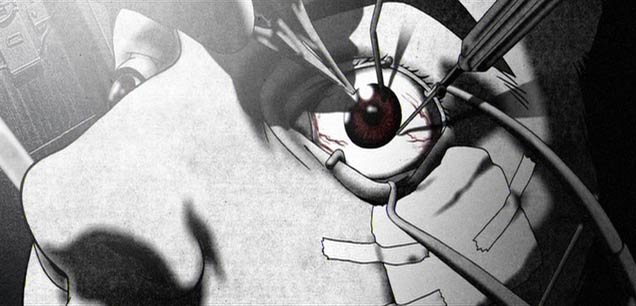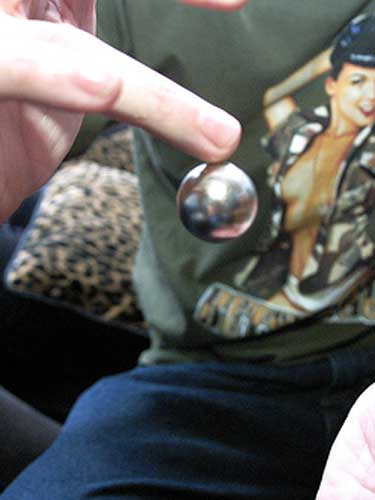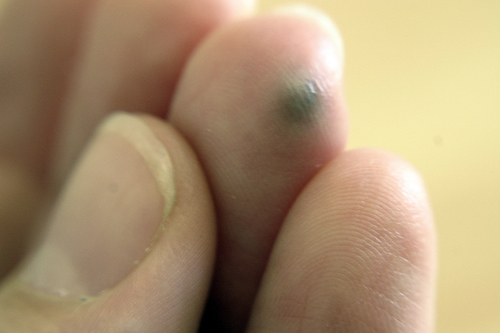
Zephyrin_xirdal has a terrific cyberpunked living post on Xirdalium where he highlights the similiarities of every day building interiors with Brazil - specifically our restaurants. In Gilliam’s Brazil, ventilation pipes are the symbol for technology run rampant. There’s something disturbing about noticing how omnipresent these things are in our restaurants. So, um, next time you check out your favorite restaurant, don’t look up!!!
This post has been filed under Cyberpunked living by SFAM.

The Institute for Ethics and Emerging Technologies (IEET), recently held a conference at Stanford University Law School on Human Enhancement Technologies and Human Rights (HETHR). The description for the conference described the purpose as follows:
Defenders of enhancement argue that the use of biotechnologies is a fundamental human right, inseparable from the defense of bodily autonomy, reproductive freedom, free expression and cognitive liberty. While acknowledging real risks from genetic, prosthetic, and cognitive enhancement, defenders of enhancement believe that bans on the consensual use of new technologies would be an even greater threat to human rights.
Health care, disability and reproductive rights activists have argued that access to technology empowers full and equal participation in society. On the same grounds a generalized right to “technological empowerment” might connect defenders of enhancement technologies with disability activists, reproductive rights activists with would-be parents seeking fertility treatments, the transgendered with aesthetic body modifiers, drug policy reformers and anti-aging researchers with advocates for dignity in dying.
Yet, what, if any, limits should be considered to human enhancement? On what grounds can citizens be prevented from modifying their own genes or brains? How far should reproductive rights be extended? Might enhancement reduce the diversity of humanity in the name of optimal health? Or, conversely, might enhancements inspire such an unprecedented diversity of human beings that they strain the limits of liberal tolerance and social solidarity? Can we exercise full freedom of thought if we can’t exercise control over our own brains using safe, available technologies? Can we ensure that enhancement technologies are safe and equitably distributed? When are regulatory efforts simply covert, illiberal value judgments?
Between the ideological extremes of absolute prohibition and total laissez-faire that dominate popular discussions of human enhancement there are many competing agendas, hopes and fears. How can the language of human rights guide us in framing the critical issues? How will enhancement technologies transform the demands we make of human rights?
The IEET is associated with the World Transhumanist Association, which is headed up by Citizen Cyborg author and Cyborg Democracy Blog contributor, James Hughes.

The Reviews: George Dvorsky, a Board member of IEET had a quick post listing a number of the reviews. Depending on which review you read for the HETHR conference, you could take away that this was either one of the most enlightening debates of the decade or that was a conference filled with left-wing crackpots espousing half-baked theories one would expect after a bad LSD trip. Not surprisingly, George thought the event was a smashing success:
The central focus of the conference was to construct a case for human enhancement based upon the lofty principles of human rights, liberalism and bodily autonomy. The event was in no small way a direct challenge to the burgeoning anti-enhancement camp that has arisen in recent years to combat what is perceived to be a threat to human dignity and humanity itself. Organizers of HETHR hoped that the conference would demonstrate that a viable and compelling case could be made in favour of enhancement. Based on what I heard at the event, I would say it was mission accomplished.
Hmmm…Mission Accomplished seems to have taken on a different meaning these past few years - yet in this case, perhaps the words were well chosen. Others clearly disagree. Wesley Smith from the Weekly Standard writes:
I just got home from a transhumanism conference (”Human Enhancement Technologies and Human Rights”) being held at Stanford through tomorrow (Sunday). Among the items I learned today are: Feminist bioethics supports genetic engineering so that men can be altered to have babies and women can be freed from the tyranny of menstruation; animals should be enhanced to permit them to become equivalent to humans, including the ability to use the Internet–before, that is, all animal life is transformed into non biological states of existence, which apparently the living planet Gaia requires in order to survive; funding anti-aging research is more important than funding treatment for fighting disease in Africa; we probably should permit people who want to be amputees to achieve their desires; and, freedom requires a maximum morphological license to enhance our biological units.
If this is at all representative, I would have to agree that the animal part is especially odd. Who gives us the right to transform elephants or Dolphins, for that matter? Modifying our brains to be able to communicate with Dolphins - Cool! Modifying dolphins to communicate with us, and only then asking their permission if this was a good idea? Not cool. Then again, I’m guessing this is a slightly biased assessment. William Saletan from Slate.com submitted a slightly kinder assessment, although not by much:
Remember those kids who played Dungeons & Dragons and ran the science-fiction club in your high school? They’ve become transhumanists….De Grey, the guy with the beard, called for higher taxes and research funding to “end the slaughter” of human aging. He argued, incoherently, that our failure to do everything possible to stop aging this instant was tantamount to mass murder. He also floated the creepy idea that overpopulation might not become a problem because once we’re immortal, we might realize children are no fun. Even so, he asked the kind of penetrating question only a big-thinking oddball would come up with. Are we stuck in a “trance” of fatalism about aging? If we realize it can be slowed or stopped, “will aging become repugnant,” like any other disease?
My favorite panel began with the president of the Toronto Transhumanist Association. He runs a Web site called betterhumans. He and I share a moral objection to killing animals. But letting animals live isn’t enough for him. Inspired by an experiment in which chimpanzees were given a kitchen and flush toilets, he wants to use cyber- and biotechnology to elevate all animals to human status. “Anything less than human-level capacity would be unacceptable,” he declared—including the ability to operate tools remotely through the Internet.
He was followed by a transsexual transbemanist. Transhumanism, apparently, is too parochial. It’s too focused on humans, too narrow for the “mindfiles,” “mindware,” and “virtuality” into which we’re going to upload ourselves. According to the speaker—picture Willie Nelson with a shave—our identities can be broken down into units called bemes, in the same way that culture can be broken down into memes. These, in turn, can be “bemed up” and preserved in media outside our bodies. As examples, she suggested your smile, how lasagna tastes to you, and your memory of your first bike ride. The idea of extracting such plainly body-dependent things is ridiculous. But her basic point is right: Bemes, not genes, are what capture and preserve our essence.
Considering I used to play D&D non-stop (I was too busy with D&D to help organize the SF&F club at school), I felt sort of an affinity here. Again though, I got the feeling from reading the reviews that perhaps the most extreme aspects of the conference were being relayed. Dale Carrico from IEET responded to this already, so I won’t too much more into it.

Brian Alexander of MSNBC linked transhumanism with the new X-Men movie - I guess this means the Transhumanism movement will suffer many key deaths along the way, but will ultimately be responsible for a problematic narrative with lots of explosions (hmmm…maybe this is accurate!). Actually, Brian’s article seemed a bit more balanced:
Transhumanism is being taken seriously by an increasing number of scholars. The fact that Stanford’s respected legal bioethics program hosted the 150 or so attendees from Europe, Asia, New Zealand and North America to discuss issues raised by human enhancement is testimony to how far transhumanism has come in from the fringe…
Still, the idea of modifying people does have a great many ethical implications, as keynote speaker Walter Truett Anderson pointed out. Anderson, president of the World Academy of Art and Science, a consultant, and an author of books about the human future, asked his audience to consider the health of the planet when they thought about what rights people should have to change our biology. There is more at stake, he said, than just ourselves. We are part of something bigger.
“We will have to think about it in a global context,” he told me. “A new population problem looms, which has to do, not with birth rates, but death rates and the question of whether we can begin to increase life spans for large numbers of people,” a prospect that could tax global resources.
The best account of the conference for those like myself who did not attend comes from Nydra’s Existence is Wonderful blog. Nydra’s Introduction and 5 Part Series goes in-depth at a number of sessions, and gives the perspective that perhaps some in-depth thought actually took place there. She does a terrific job at laying out the POV of the speakers, and then gives her thoughts on it. While I may not agree with her on everything, I certainly very much appreciate the detailed effort she put into this, and will probably spend lots more time perusing them.

Left Wing Loonies or Something More? The Slate review above briefly mentions a struggle for the heart and soul of the Transhumanist movement in saying, “A while back, I’m told, there was a left-right battle for the soul of transhumanism, and the left won..” It appears that one casualty of this struggle is Simon Young. He has the belief that the World Transhumanist Association and its leader, James Hughes, are members of the “Loony Left,” who have essentially gone off the deep end of transhumanist thought. He details his thoughts in Wesley Smith’s review above. His biography states the following:
“Son of the pioneering English cybernetician and author, J. F. Young ( 1929-94), whose seminal books included Cybernetics (1969), Robotics (1973), and Cybernetic Engineering (1973) , Simon Young is an accomplished pianist and composer who has performed across Europe . This unusual combination of influences, musical romanticism and scientific rationality, informs his Transhumanist philosophy – the passionate belief in striving to transcend human limitations through reason, science and technology.”
I have a masters in Cybernetics and General Systems Theory, but I must confess that I’ve never heard of his father’s books (more to add to the stack I suppose). In any event, Simon has created a competing organization called the World Transhumanist Society. On the whole, I sort of like his evolution over revolution approach, but the WTS at this point seems like nothing more than a web page. Has anyone joined this, or is Simon a lost voice in the wilderness?

So What Do I Think of All This? As for my own thoughts, I must admit, I’m still thinking about this whole movement, so if my thoughts seem ill-formed, please feel free to set me straight. The part that really bothers me about this whole debate deals with the seemingly single-minded pursuit of transhumanism without regard to the massive potential for unintended consequences. Our cyberpunked future may indeed be wonderful, but it has just as much potential to turn into a modern-day dystopia, not unlike many of the movies we see here. If my schooling in anthropology and cybernetics has taught me anything, it’s that most people think in terms of cause and effect changes, while actual change is very counter-intuitive and interlinked - making explicit wholesale changes to society really should involve an understanding of the complexities involved. Societies are held together by stable patterns of interaction and some semblance of a shared way of life. Simply because we develop the power to change every aspect of ourselves or our society doesn’t necessarily imply that doing so will result in the betterment of mankind. By no means am I advocating we should rise up in anger at the transhumanism movement, but we should demand enlightened thought, and a comprehensive societal risk assessment for innovations that could lead to massive societal change.
In terms of priorities, it seems rather clear that the HIGH priority for posthuman research (after the development of high quality vampire teeth, of course) should be in helping those with disabilities and lost body parts. If there is anything good about the Iraq conflict, its the massive dollars going into research in prosthetics.
Thoughts?
This post has been filed under Cyberpunked living, News as Cyberpunk by SFAM.

Quinn Norton from Wired has a pretty intriguing article on using magnets as body implants in order to begin to develop awareness of electromagnetic fields. He actually went ahead and got a magnetic implant in his finger.
I took a trip to Phoenix to have Haworth implant a magnet in me last September. Because body-mod artists are not medical practitioners, ice was the only anesthetic available. My finger was soaked in ice water until it began to hurt. After that, Haworth acted quickly to get as much of the implant done as possible while my hand was still numb from the cold.
The initial cut did hurt, but not unbearably. He sliced open my finger with a standard scalpel, inserted a tool to make a gap for the magnet, and tried to insert the magnet in one nonstop motion. The insertion didn’t work, and he widened the cut and tried again. This time it worked, and he closed the cut with a single suture. The suture was the most painful step — an indicator that the cold “anesthetic” had worn off. The process took less than 10 minutes. My finger was slightly swollen and sported a blue, knotted plastic thread.
When we were done we sat in Haworth’s living room. He brought out a magnet and handed it to me. I brought it near my finger and felt the magnet move for the first time up against the raw inside of my finger. I startled visibly, and Haworth grinned. “Welcome to your new sense,” he said…
…The magnets are small, and once encased in skin, all they do is react next to nerves, conveying the presence of sufficiently strong electromagnetic fields. “The magnetic implant is not the most sophisticated or rich sensation, it was just the easiest to implement with our available technology,” says Huffman.

Damn! Soaking your finger in ice and then slicing?? That’s true hardcore!! Unfortunately, things don’t always go as expected. Often, the silicon coating breaks down, rendering your finger prone to infection. Bezine has an article that graphically shows the removal procedure when things go wrong.
Several months after having the procedure, some people begin to have problems. Some magnets begin to turn dark under the skin, suggesting the bio-neutral silicone sheath is failing. Exposure to the body starts breaking down the magnets.
Two months after my own magnet was inserted, and long after the cut itself had healed, I experienced one of these problems firsthand. My shielding breached and the implant area became infected. The infection resolved, but the region turned black and my sixth sense evaporated.
My family doctor tried to remove the magnet and failed. Instead, the implant shattered into pieces, and I could no longer pick up other magnets with my finger. After months of ESP, all I had left was a sore digit with a dark spot.
I figured that was the end, but it wasn’t. Four months after I lost all effect, the spot darkened and the magnetism returned. The magnet — being a magnet — had reassembled itself in my finger. While it’s nowhere near as sensitive as it once was, I can once again pick up other magnets.
The interesting thing this shows is that decent percentage of the population are really interested in expanding human capabilities through technology enabled solutions. True cyborgs aren’t going to remain solely in the realm of science fiction for long. But um, hopefully they get better anesthetics than ice for this type of operation in the future.
This post has been filed under Cyberpunked living by SFAM.

PC Magazine has a wonderful article on MIT Media Lab’s RadioActive phones. These phones allow their owners to do podcasts directly through the phone which is then uploaded into a pretty slick site that adds metadata to it, associating the podcast to all potentially interesting connections.
By and large, more people are turning to their mobile devices for entertainment, says Donath, but rather than call, and potentially annoy, a friend, it would be ideal to “conveniently drop into an [ongoing] discussion and drop out when you’re done.”
…The RadioActive project, which Donath (MIT) created with student Aaron Zinman, defines a large-scale asynchronous audio messaging system, or mobile audio forum. In this system, voice messages, which are short audio sound bytes, are exchanged between groups of users via mobile devices, like cell phones or PDAs, as a method of “discussion-on-demand.”
…Just like an email application or an RSS reader, RadioActive supplies its users with an inbox, which displays the first message of discussion threads that have been subscribed to or are contextually relevant. For instance, location may be one factor the system takes into account when determining contextual relevance. In this scenario, threads relating to New York City restaurants may appear in the inbox as the user walks around Manhattan.
While this functionality in itself is pretty interesting, the thought that occurs to me is that this is just another step in a societal change where we know where everyone is at all times and where all communications are potentially monitored. Paranoid parents already have the ability to keep tabs on their children 24/7; now a jilted lover has to worry about the possibility of his or her significant other secretly “podcasting” their breakup discussion because this would be so dramatic that it would be a surefire hits generator on whatever the hot social networking site was at the moment.

The trend is clear: reality shows and social software technologies are transforming you an I into the stars of the modern media age. Our movie stars are quickly losing their sacred pedestal as the voice and face of society. The societal actors are becoming the nameless many, who now can make a name for themselves by podcasting the latest bizarre incident in their lives for all to see. Yes, as the article suggests, we can use the podcasts to immediately broadcast to Manhattan that our crab cakes at Crabs-R-Us contained too much filler, but over time, the game show host mentality will take over. Then the question facing society will not be too dissimilar from the question explored in Final Cut: how will people act when they know that potentally all their interactions are being recorded for others’ consumption?
Andy Warhol’s 15 minutes of fame is based on the presupposition that there was an agreed-upon, discrete stage. In the cyberpunked present, our 15 minutes of fame has been converted into a potential 24 hour-a-day fame on one of a bazillion media outlets. Every interactive website is now in direct competition with cable & network TV. We all compete for your attention. To the extent you participate, you become part of the new internet reality shows. So “podcast away” ladies and gents!
This post has been filed under Cyberpunked living, News as Cyberpunk by SFAM.

Ted Koppel wrote an OP-ED for the New York Times earlier this week entitled “These Guns for Hire.” I would link to the New York Times, but they’ve gone to a pay-per-view model. Luckily, many political bloggers reprint the information - here’s a link to it. In this article, Mr. Koppel discusses a recent trend with respect to privatizing the military:
There is something terribly seductive about the notion of a mercenary army. Perhaps it is the inevitable response of a market economy to a host of seemingly intractable public policy and security problems.
Consider only a partial list of factors that would make a force of latter-day Hessians seem attractive. Among them are these:
*Growing public disenchantment with the war in Iraq;
*The prospect of an endless campaign against global terrorism;
*An over-extended military backed by an exhausted, even depleted force of reservists and National Guardsmen;
*The unwillingness or inability of the United Nations or other multinational organizations to dispatch adequate forces to deal quickly with hideous, large-scale atrocities (see Darfur and Congo);
*The expansion of American corporations into more remote, fractious and potentially hostile settings.
Just as the all-volunteer military relieved the government of much of the political pressure that had accompanied the draft, so a rent-a-force, harnessing the privilege of every putative warrior to hire himself out for more than he could ever make in the direct service of Uncle Sam, might relieve us of an array of current political pressures.
In the Op-Ed Koppel does a nice job of exposing the issues with having privatized firms maintain their own mercenary force. There is clearly a conflict of interest between a country’s interest (The US in this case) and a corporation’s concerns.
So, if there are personnel shortages in the military (and with units in their second and third rotations into Iraq and Afghanistan, there are), then what’s wrong with having civilian contractors? Expense is a possible issue; but a resumption of the draft would be significantly more controversial.
Moreover, contractors provide the bodyguards (most of them veterans of the American, British, Australian, Nepalese or South African military) and, in some cases, the armored vehicles and even helicopters that have become so necessary for the conduct of business by foreign civilians in Iraq. Such protective services are employed by practically every American news agency and, indeed, are responsible for the security of the American ambassador himself.
So, what about the inevitable next step — a defensive military force paid for directly by the corporations that would most benefit from its protection? If, for example, an insurrection in Nigeria threatens that nation’s ability to export oil (and it does), why not have Chevron or Exxon Mobil underwrite the dispatch of a battalion or two of mercenaries?
This linkage with oil companies is terrific in that watching the CEOs being interviewed about the insanely high oil prices, they flat out say their job is to make money for the shareholders, NOT to keep prices low. In discussing the possibility with a mercenary-for-hire company, the following exchanges took place:
Chris Taylor, the vice president for strategic initiatives and corporate strategy for Blackwater USA, wanted to be sure I understood that such a thing could only happen with the approval of the Nigerian government and at least the tacit understanding of Washington. But could Blackwater provide a couple of battalions under those circumstances? “600 people in a battalion,” he answered. “I could source 1,200 people, yes. There are people all over the world who have honorably served in their military or police organizations. I can go find honorable, vetted people, recruit them, train them to the standard we require.”
What then if the commercial interests of a company or foreign government hiring one of these security contractors comes into conflict with the interests of the United States government? Mr. Taylor of Blackwater doesn’t even concede the possibility. “At the end of the day,” he said, “we consider ourselves responsible to be strategic partners of the U.S. government.” To which he then added, perhaps a little more convincingly: “If we went against U.S. government interests we would never get another contract.”
This last line is the real issue. As long as this is profitable for a corporation, they will support their affiliated government. While I certainly don’t believe that lifetime soldiers of a country would ever go against it in any real numbers, this is a global economy - mercenaries can be outsourced. Corporations are multi-national. If there EVER was a REALY BAD idea that has been floated around recently, this is it. Talk about the start to a cyberpunked future! If the trend moves towards corporate control of our protection, we truly will be on a dystopic path.
This post has been filed under Cyberpunked living by SFAM.

Cyberpunked life continues down the path of the bizarre. The New York Times recently had a very well done article on Japan’s Media Immersion Pods. In Japan, people escape the pressures of society by checking into a Cyber Café for hours on end - sometimes even overnight. Tokyo is now littered with Cyber Cafés that have vast stacks housing all varieties of media (see above) including movies, mangas, music, games, porn, and anything else that captivates the infomania craze. People take these materials back to media immersion pods, which are essentially cube farms, completely decked out with computers, headphones lounge chairs and reading space.
In the world’s most media-saturated city, people take a break by checking themselves into media immersion pods: warrens cluttered with computers, TV’s, video games and every other entertainment of the electronic age.
The Bagus Gran Cyber Cafés are Tokyo’s grand temples of infomania. Situated well above retail level, on the odd floor number where in Manhattan you might find tarot readers or nail salons, these establishments contain row after row of anonymous cubicles. At first glance the spread looks officelike, but be warned: these places are drug dens for Internet addicts.

Apparently, the Cyber Cafés offer an oasis away from modern Japanese society where someone can shed their social encasement in favor of anonymity. In the “real” world, Japanese society is very structured to the point that an individual’s interactions and modus operandi are significantly influenced by their job, family, social status, etc. Cyber Café users are able to pursue their fantasies without reality intruding on them. There are even pods for couples, where couples watch porn and make out, without regard for others just a cube over.
Hidenori Kimura, a sociologist who writes about intercultural encounters, said he believes the Gran Cyber Cafés fulfill a deep and persistent cultural longing. The Japanese system of competition for education, career and social esteem, Dr. Kimura explained, forces young people to obsess over self-presentation, which costs them both fantasy and anonymity, the privileges of childhood. What Japanese young people want, in his view, are opportunities to be free of their social status.
“Traditionally,” he explained, “tea ceremonies and festivals have been fulfilling this role of depriving people of their social status and thus help them become ‘nobody.’ Tea ceremonies deprived the feudal elites of their status and made them just a person enjoying tea ceremony and tea, while festivals among farmers offered an enclave of anarchy during the festivals where they were free of norms and rules of feudal eras.”
The Gran Cyber Cafés now serve this purpose, he said. “Nobody cares what you do, which enables you to be absorbed in whatever fantasy you want to indulge in through Net surfing, Web games or manga. Yet you can satisfy your timid desire to belong.” Staying in the Gran Cyber Cafés, he concluded, is now part of jibun-sagashi, or the search for the true self.
Said another way, the pressures placed on us by the complexification of modern society along with the changes brought about the infomania craze has created significant numbers of infomania addicts. Similar to the opium dens in years past, the Cyber Cafés offer people in society an escape - only this time, instead of checking out, they are checking in. The Cyber Café users of Japan completely immerse themselves in infomedia world as a way of checking out from society. One wonders if this response is unique to Japanese culture, or whether we’ll see the same type of place cropping up in the rest of the industrialized world.
This post has been filed under Cyberpunked living by SFAM.

If there was ever a storyline I expected to see in Transmetropolitan, this is it! I’m guessing many of you have seen the USA Today special on the illegal selling of human body parts. You take your dead gramps to be cream-mated, and you get ashes alright, but they aren’t his. Instead, the crematorium or their employees have carved up his body and has cleared many thousands for selling all of his parts (hands, head, shoulder, eyes, legs, etc.) and organs (liver, brain, heart, lungs, etc.). Lest you think a regular burial prevents this outcome, you better check gramps’ insides before you lower the coffin - his brain may already be on its way to your favorite research facility by then!
Trafficking in body parts illegally harvested from the dead is a lucrative, underground business driven by growing demand for human bones and tissue, a USA TODAY investigation has found…Funeral home employees, crematorium operators and others with access to the recently deceased have secretly dismembered corpses, taking non-organ body parts such as knees, spines, bone and skin without the knowledge or consent of family members….
…Modern-day body snatchers provide bones, tendons and body parts other than transplantable organs to tissue banks, research facilities and other buyers. What they get paid: $600 for a brain, as much as $850 for an elbow, up to $850 for a hand, according to an analysis of market prices for fresh or frozen body parts used for research and education that was compiled by Annie Cheney, author of Body Brokers: Inside America’s Underground Trade in Human Remains.
Demand for tissue is growing. More than 19,000 square feet of skin were distributed in 2003 for transplant from accredited tissue banks, according to the American Association of Tissue Banks (AATB), up from 7,700 square feet in 1999. About 3,300 heart valves were distributed in 2003, up from 1,300 in 1999. Tumors and excess tissue that were once incinerated as waste can now be probed for DNA markers to help doctors understand disease.
Sometimes this business is enacted by individuals looking to make a buck, but more disturbing is the trend where the crematorium and other organizations themselves do this as their normal course of business.
If nothing else, this trend points to a further decay in the former “sacredness” of humanity. As we move toward a post-human, cyberpunked world, the perception of “uniqueness” each of us imagines we as individuals have begins to wear off. Moral boundaries are weakened, and behaviors previously thought taboo become commonplace. Welcome to the new world!
This post has been filed under Cyberpunked living by SFAM.

Just another update on Jesse Sullivan, the guy with two bionic arms. Socialunravelin from the Livejournal cyberpunk collective found a video of Jesse Sullivan moving his arms. This is too cool.
One wonders after this technology becomes more commonplace if they start moving away from limbs that mimic human ones. It seems to me we have an opportunity for a whole new branch of evolutionary development in the post-human world. When this occurs, non-amputees will start to attach these things as well.
This post has been filed under Cyberpunked living by SFAM.
In yet another “as strange as fiction” story, scientists are experimenting with a process that grows meat in an incubator. Similar to a breadmaker, the idea is you give your new “Ronco Meat Maker” a few cells of whatever tasty dead animal you’re interested in growing (perhaps a few pre-chewed bites of a really tasty hamburger you didn’t finish), then add whatever the meat equivalent of yeast is - close the lid and presto! A short while later, you have a large hunk of “pre-dead” animal just waiting to be consumed!
Instead of being cut from a farm animal, the beef, pork or chicken would be grown in incubators from a few starter cells, a growth medium and some hormones to get the cells to divide.
The first attempts by scientists who grow animal muscle tissue in the lab have been small in scale. But researchers are looking forward to the day when meat could be cultivated in industrial bioreactors or even in a device sitting on a kitchen counter…
…He said a device similar to a bread maker could one day be used to manufacture meat in the home.
Matheny said muscle produced in an incubator could have reduced fat content, and the process would do away with problems such as bacterial contamination and mad cow disease.
Call me crazed, but this seems to have all sorts of bizarre uses. Does this mean that in the future, when someone says, “eat me, asshole!”, you’re supposed to scrape off a few skin cells and put them in your Ronco Meat Maker machine? If so, what’s the comeback line supposed to be - “Will you supply katsup with that?”
In any event, it looks like the best this thing can do is create pre-processed meat items, so don’t expect a T-Bone steak out of the deal. And apparently, growing meat in an incubator leaves something to be desired in terms of taste - early tests show that grown frog muscle tissue tastes like “Jelly on a cloth.” Yum!
This post has been filed under Cyberpunked living by SFAM.

Prosthetic linbs have really come a long way. Now we have instances of people controlling fully integrated artificial limbs with their regular nervous system.
His arms were amputated. Jesse woke from a monthlong coma to discover his limbs gone, his life changed…Dr. Kuiken explained to me that, shortly after the accident, Jesse underwent surgery, and was essentially rewired. Live nerves that control arm and hand movements — nerves that were severed — were re-directed to Jesse’s pectoral muscles in his chest. Electrodes were then attached to the chest, and connected to the robotic arm.
For 59-year-old Jesse Sullivan, who lives in Dayton, Tennessee, it’s all part of everyday life in. Jesse is a bionic man. Think science fiction…Jesse’s brain now thinks that when his pectoral muscles move, his arm, wrist and elbow are moving. When Dr. Kuiken touches points on his chest, Jesse feels as if the doctor is touching his thumb, or the palm of his hand.
The dawning of the cyborg has arrived. Currently, we only envision replacing lost limbs. At some point when this becomes commonplace, we will most likely begin to envision radically different forms of body modification.
This post has been filed under Cyberpunked living, News as Cyberpunk by SFAM.
|



















